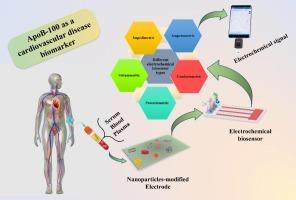The role of electrochemical biosensors in monitoring Apolipoprotein B-100 as a diagnostic tool for cardiovascular disease
IF 4.9
2区 化学
Q1 CHEMISTRY, ANALYTICAL
引用次数: 0
Abstract
Cardiovascular disease (CVD) is the leading cause of global mortality. Early identification of CVD and subsequent intervention can significantly improve treatment outcomes. A successful approach to promptly diagnose CVD involves identifying biomarkers present in bodily fluids. Apolipoprotein B-100 (apoB-100) is a critical biomarker associated with CVD and plays a significant role in its progression. Elevated levels of apoB-100 (>100 mg/dL) are linked to a higher risk of CVD, underscoring its importance for accurate diagnosis and effective treatment strategies. Electrochemical biosensors offer advantages in monitoring apoB-100 due to their speed, portability, and on-site analysis capabilities. This review provides a comprehensive analysis of how apoB-100 levels change in biological fluids as CVD advances. It includes a detailed explanation of the construction and analytical capabilities of various electrochemical sensors. A comparison of electrochemical biosensors using amperometric, potentiometric, voltammetric, conductometric, and impedimetric methods is presented. Additionally, the suitability of these sensors for measuring apoB-100 in clinical samples, including serum, plasma, whole blood, and other bodily fluids, is evaluated. Furthermore, the challenges associated with electrochemical sensors as diagnostic tools for apoB-100 in CVD biomarker detection are examined, and potential future directions and trends are outlined.

电化学生物传感器在监测载脂蛋白 B-100 作为心血管疾病诊断工具中的作用
心血管疾病(CVD)是导致全球死亡的主要原因。及早发现心血管疾病并进行干预,可以大大改善治疗效果。及时诊断心血管疾病的成功方法包括识别体液中的生物标志物。载脂蛋白 B-100(apoB-100)是一种与心血管疾病相关的重要生物标志物,在心血管疾病的发展过程中起着重要作用。载脂蛋白B-100水平升高(100毫克/分升)与心血管疾病的高风险有关,突出了其对准确诊断和有效治疗策略的重要性。电化学生物传感器在监测载脂蛋白B-100方面具有快速、便携和现场分析能力等优势。本综述全面分析了随着 CVD 的发展,载脂蛋白 B-100 在生物液体中的水平是如何变化的。文中详细介绍了各种电化学传感器的构造和分析能力。报告对使用安培法、电位法、伏安法、电导法和阻抗法的电化学生物传感器进行了比较。此外,还评估了这些传感器测量临床样本(包括血清、血浆、全血和其他体液)中载脂蛋白 B-100 的适用性。此外,还探讨了在心血管疾病生物标记物检测中将电化学传感器作为载脂蛋白 B-100 诊断工具所面临的挑战,并概述了潜在的未来发展方向和趋势。
本文章由计算机程序翻译,如有差异,请以英文原文为准。
求助全文
约1分钟内获得全文
求助全文
来源期刊

Microchemical Journal
化学-分析化学
CiteScore
8.70
自引率
8.30%
发文量
1131
审稿时长
1.9 months
期刊介绍:
The Microchemical Journal is a peer reviewed journal devoted to all aspects and phases of analytical chemistry and chemical analysis. The Microchemical Journal publishes articles which are at the forefront of modern analytical chemistry and cover innovations in the techniques to the finest possible limits. This includes fundamental aspects, instrumentation, new developments, innovative and novel methods and applications including environmental and clinical field.
Traditional classical analytical methods such as spectrophotometry and titrimetry as well as established instrumentation methods such as flame and graphite furnace atomic absorption spectrometry, gas chromatography, and modified glassy or carbon electrode electrochemical methods will be considered, provided they show significant improvements and novelty compared to the established methods.
 求助内容:
求助内容: 应助结果提醒方式:
应助结果提醒方式:


